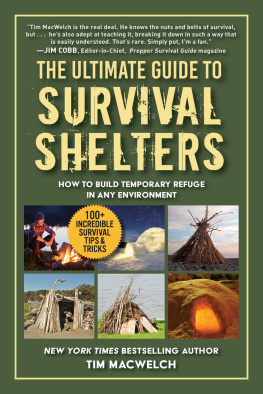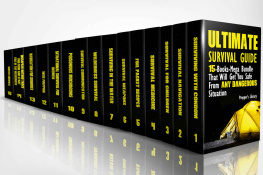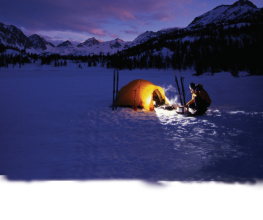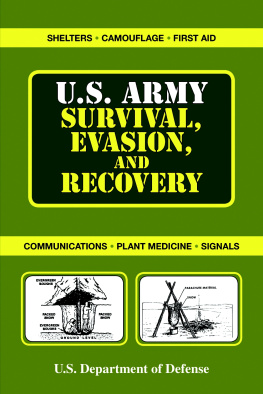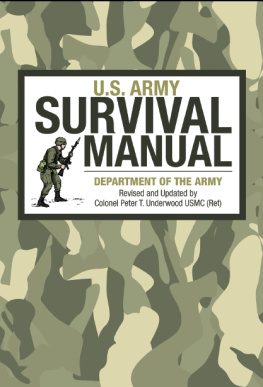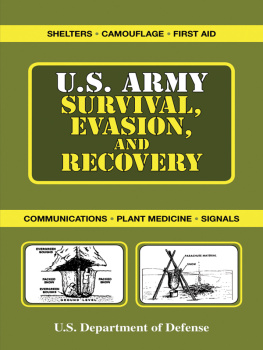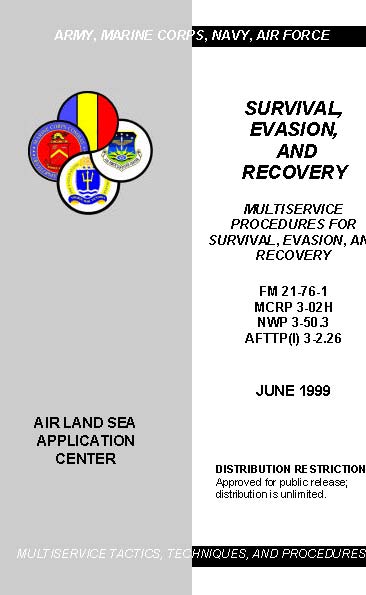QUICK REFERENCE CHECKLIS T Decide to Survive !
S - S ize up the situation, surroundings, physical condition, equipment.
U - U se all your senses
R - R emember where you are.
V - V anquish fear and panic. I - I mprovise and improve.
V - V alue living.
A - A ct like the natives.
L - L ive by your wits.
Immediate Actions
a. Assess immediate situation. THINK BEFORE YOU ACT!
b. Take action to protect yourself from nuclear, biological, or chemical hazards (Chapter IX).
c. Seek a concealed site. d. Assess medical condition; treat as necessary (Chapter V). e. Sanitize uniform of potentially compromising information. f. Sanitize area; hide equipment you are leaving. g. Apply personal camouflage. h. Move away from concealed site, zigzag pattern recommended. i. Use terrain to advantage, communication, and concealment. j. Find a hole-up site.
Hole-Up-Site (Chapter I)
a. Reassess situation; treat injuries, then inventory equipment. b. Review plan of action; establish priorities (Chapter VI). c. Determine current location. d. Improve camouflage. e. Focus thoughts on task(s) at hand. f. Execute plan of action. Stay flexible!
Recommend inclusion of this manual in the aviators survival vest.
i
Concealment (Chapter I)
a. Select a place of concealment providing
(1) Adequate concealment, ground and air.
(2) Safe distance from enemy positions and lines of communications (LOC).
(3) Listening and observation points. (4) Multiple avenues of escape. (5) Protection from the environment. (6) Possible communications/signaling opportunities. b. Stay alert, maintain security. c. Drink water.
Movement (Chapters I and II)
a. Travel slowly and deliberately.
b. DO NOT leave evidence of travel; use noise and light discipline.
c. Stay away from LOC. d. Stop, look, listen, and smell; take appropriate action(s). e. Move from one concealed area to another. f. Use evasion movement techniques (Chapter I).
Communications and Signaling (Chapter III)
a. Communicate as directed in applicable plans/orders, particularly when considering transmitting in the blind . b. Be prepared to use communications and signaling devices on short notice. c. Use of communications and signaling devices may compromise position.
Recovery (Chapter IV)
a. Select site(s) IAW criteria in theater recovery plans. b. Ensure site is free of hazards; secure personal gear. c. Select best area for communications and signaling devices. d. Observe site for proximity to enemy activity and LOC. e. Follow recovery force instructions.
ii
| FM 21-76-1 MCRP 3-02H NWP 3-50.3 AFTTP(I) 3-2.26 |
|---|
| FM 21-76-1MCRP 3-02HNWP 3-50.3AFTTP(I) 3-2.26 | U.S. Army Training and Doctrine Command Fort Monroe, Virginia Marine Corps Combat Development Command Quantico, Virginia Navy Warfare Development Command Newport, Rhode Island Headquarters Air Force Doctrine Center Maxwell Air Force Base, Alabama |
|---|
| 29 JUNE 1999 |
|---|
Survival, Evasion, and Recovery
Multiservice Procedures fo r Survival, Evasion, and Recover y
Note: This UNCLASSIFIED publication is designed to provide Service members quick-reference survival, evasion, and recovery information. See Appendix B for the scope, purpose, application, implementation plan, and user information.
TABLE OF CONTENTS
Page CHAPTER I EVASION
- Planning.......................................................................................I-
- Camouflage..................................................................................I-
- Shelters........................................................................................I-
- Movement .................................................................................... I-
CHAPTER II NAVIGATION
- Stay or Move Considerations ..................................................... II-
- Navigation and Position Determination ................................... II-
- Travel Considerations................................................................. II-1
- River Travel................................................................................. II-1
- Ice and Snow Travel ................................................................... II-1
- Mountain Hazards ...................................................................... II-1
- Summer Hazards ........................................................................ II-1
- Dry Climates................................................................................ II-1
iii
9. Tropical Climates ........................................................................ II-1
10. Open Seas ................................................................................... II-1
CHAPTER III RADIO COMMUNICATIONS AND SIGNALING
1. Radio Communications (Voice and Data).................................. III-
2. Signaling ...................................................................................... III-
CHAPTER IV RECOVERY
1. Responsibilities............................................................................ IV-
2. Site Selection...............................................................................IV-
3. Site Preparation..........................................................................IV-
4. Recovery Procedures .................................................................. IV-
CHAPTER V MEDICAL
1. Immediate First Aid Actions......................................................V-
2. Common Injuries and Illnesses.................................................. V-
3. Plant Medicine............................................................................. V-1
4. Health and Hygiene .................................................................... V-1
6. Rules for Avoiding Illness........................................................... V-1
CHAPTER VI PERSONAL PROTECTION
1. Priorities ...................................................................................... VI-
2. Care and Use of Clothing .......................................................... VI-
3. Other Protective Equipment...................................................... VI-
4. Shelters........................................................................................VI-
5. Fires ............................................................................................. VI-
CHAPTER VII WATER
1. Water Requirements .................................................................. VII-
2. Water Procurement .................................................................... VII-
3. Water Preparation and Storage................................................. VII-


